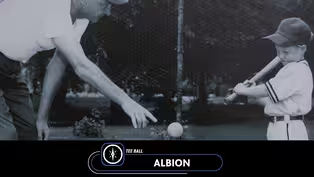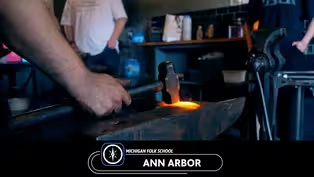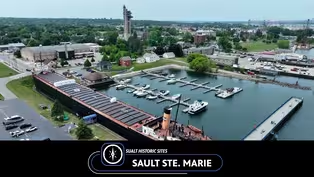Destination Michigan
Keweenaw Peninsula
Clip: Season 16 Episode 4 | 6m 25sVideo has Closed Captions
Keweenaw Peninsula
Join us on a Yooper adventure with a visit to the Keweenaw Peninsula to discover its hearty history, breathtaking beauty, and cool communities.
Problems playing video? | Closed Captioning Feedback
Problems playing video? | Closed Captioning Feedback
Destination Michigan is a local public television program presented by WCMU
Destination Michigan
Keweenaw Peninsula
Clip: Season 16 Episode 4 | 6m 25sVideo has Closed Captions
Join us on a Yooper adventure with a visit to the Keweenaw Peninsula to discover its hearty history, breathtaking beauty, and cool communities.
Problems playing video? | Closed Captioning Feedback
How to Watch Destination Michigan
Destination Michigan is available to stream on pbs.org and the free PBS App, available on iPhone, Apple TV, Android TV, Android smartphones, Amazon Fire TV, Amazon Fire Tablet, Roku, Samsung Smart TV, and Vizio.
Providing Support for PBS.org
Learn Moreabout PBS online sponsorship(screen whooshing) (lively music) - The Keweenaw Peninsula is a landmass that juts into the heart of Lake Superior.
We like to refer to ourselves as the Upper Peninsula's Upper Peninsula.
- [Adam] A journey to the Keweenaw begins fittingly with a bridge crossing over the Portage Lake Lift Bridge, known as the Gateway to the Keweenaw.
Once across, it doesn't take long to notice the signs that you've arrived in Copper Country.
- It was the epicenter of a massive copper boom in the 1850s, 1860s and into the early 1900s.
So at that time when copper was discovered in an economical fashion, you know, we had tens of thousands of people locate here.
At one point in time, Houghton County was the second most populous county in the state of Michigan, second only to Wayne County, Michigan.
So you have, you know, communities that popped up along where all these either shipping opportunities or mining camps were located.
And many of those communities, even after the population collapsed in the, you know, early 1900s 'cause mining became uneconomical in the region, those communities still exist, right?
And so they're small, they're quaint, they're Midwestern nice.
You know, a lot of times, right, these are small communities that have really grown up around, again, the nature, the lake shore.
It's a really cool experience for people to come in.
And every little community has its own personality, which I think is really fascinating for people to come up here.
You know, Copper Harbor is straight out of the West Coast, right?
Like if you're in the Pacific Northwest, you feel like you're out there in Oregon or Washington State because of all the access to water and nature and all that kind of fun stuff, outdoor recreation trails.
Eagle Harbor's a sleepy little community, got a beautiful lighthouse, great places to eat, again right there on the water.
Calumet is pretty much the epicenter of the historical copper room here in the Keweenaw.
So the Keweenaw National Historical Park's headquarters and visitor center is located right in Calumet.
And then right across the street is the beautiful community of Laurium, which also has a lot of the old historical homes that were built during the mining heyday.
Many of the mansions that were built because of the mining bosses that were making a lot of money, they decided to live in Laurium.
So you can go up and down the street and see these beautiful homes that are still maintained, many of which you can actually stay in.
Of course, the metro, you know, the big city if you will, is Houghton and Hancock.
That's where a lot of your lodging, your dining amenities and of course the home to Michigan Technological University is located in Houghton.
And that brings in a lot of cool experiences for, you know, visitors and locals alike.
- [Adam] In 1992, Congress established the Keweenaw National Historical Park to preserve and interpret the region's copper mining history.
The park includes the Calumet Visitor Center in downtown Calumet.
- Most people, when they expect a national park, you enter the gate and you see this expansive view.
But here you get that, but in different aspects.
You know, we still have our entrance sign and right behind it, the statue of Agassiz.
And you change your mind is what I like to think is turn on that time capsule and think back to the early 1900s, and how diverse and changed, but also still standing these historic buildings are that we are here to preserve and protect.
- [Adam] The visitor center spans three floors filled with photos, exhibits, and artifacts that bring the story of copper mining to life.
Guests can join guided tours or receive a personalized itinerary to explore more than 20 unique heritage sites spread across the peninsula, each telling part of the history and legacy of the copper mining boom.
- Calumet is actually a very small geographically village.
It's only like 100 acres now, and it started out even smaller than that as what the mining companies were willing to set aside to allow for private development.
At one point in time, that 90 or so acres hosted about 5,000 people, which is comparable to the population density in Brooklyn today.
So there were a lot of people crammed into a very small amount of space.
And as often happens, particularly in areas where you heat seven or eight months out of the year, things were vulnerable to fire.
And so you see a lot of brick and sandstone and just substantial construction.
- [Adam] The National Historical Park partners with sites managed by state and local governments, private businesses and nonprofit organizations, one of the most notable being the historic Calumet Theater.
- Well, the Calumet Theater was built as a nation's first municipal theater.
It was owned by the people and it was for the people.
And from the very beginning through to today, it's been a place where graduations were held and community groups, such as the Masons and Odd Fellows would have gatherings and events.
It's also been very important to draw the connections between Calumet and the broader world because some of the biggest names in showbiz were performing on the stage here.
It shows you that economic, a part of the story again, that this was a place for Sarah Bernhardt, Madame Modjeska, John Philip Sousa, and others to visit.
- [Adam] Spending time in the theater, exploring Calumet and immersing yourself in the Keweenaw makes it easy to imagine what life was like here during the mining heyday.
- All that wealth that was generated from the copper boom, there was a lot of impressive activity, a lot of folks relocated to this region.
And then with that came towards.
So back in the 1850s, we have evidence of people coming and taking laker ships from Chicago up here to breathe in the clean air and experience the wellness values of nature.
That really kind of kicked off this idea of the UP and the Keweenaw being a place for people who had time and money to come up here and recreate natural beauty and the outdoors.
The Keweenaw digs into people's soul.
Like that's what I hear people say when they come up here.
Some people have this spiritual connection when they come up here.
Whether it's the Lake Superior, it's the great outdoors, it's the friendly people, there's just something about the Keweenaw that just kind of claws into you and you say, "That place is unique and special."
And there's no other way to put it into words.
It's just a feeling that people get when they get up here.
And I think it's because it's a chance for people to take that deep breath and just kind of let some of those worries and those cares just slip away 'cause things move a little bit slower up here.
That lack of cell phone service, you know, it's something that allows you to disconnect and really appreciate it.
So that history, it's the people, it's the connection with nature.
You put those three things together, it's a pretty cool experience.
(screen whooshing)
Providing Support for PBS.org
Learn Moreabout PBS online sponsorshipSupport for PBS provided by:
Destination Michigan is a local public television program presented by WCMU


















